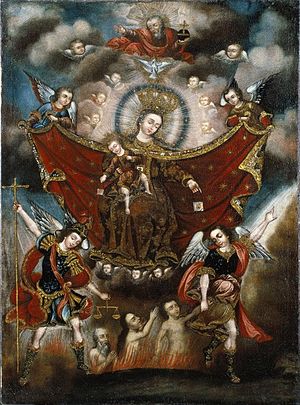- Diego Quispe Tito
-
 Virgin of Carmel Saving Souls in Purgatory, Circle of Diego Quispe Tito, 17th c., collection of the Brooklyn Museum
Virgin of Carmel Saving Souls in Purgatory, Circle of Diego Quispe Tito, 17th c., collection of the Brooklyn Museum
Diego Quispe Tito (1611—1681) was a Peruvian painter. He is considered the leader of the Cuzco School of painting.[1]
The son of a noble Inca family, Quispe Tito was born in Cuzco, and worked throughout his life in the district of San Sebastián; his house is still extant, and shows his coat of arms on its door. His earliest signed painting is an Immaculate Conception from 1627, gilded in a fashion typical of the Cuzco school. The work's elongated forms reveal a knowledge of Mannerism; where Quispe Tito learned the style is unknown, but it is hypothesized that he encountered it in the work of Italian Jesuit Bernardo Bitti, who was active at the time in Cuzco. In addition, he is believed to have known Luis de Riaño in his youth, and may have derived some elements of his style from the older artist; de Riaño, a painter from Lima, had trained in the workshop of Angelino Medoro, and so would have provided another source of Italian influence.
Quispe Tito also was influenced in his work by engravings from Flanders; indeed, his best-known work, the 1681 Signs of the Zodiac in Cuzco Cathedral, is a series of copies of Flemish engravings in which each zodiac sign is tied to a parable from the life of Christ. These engravings were designed for distribution in Peru, where worship of the sun, moon, and stars was still practiced in some quarters; they were designed to encourage worship of Christ and His miracles in place of the zodiac. A further series, depicting scenes from the life of John the Baptist and dating to 1663, was also produced on Flemish models.
Quispe Tito also incorporated several personal elements into his work; most notable was his use of gilding and his depiction of spacious landscapes filled with birds and angels. In 1667 he painted several scenes from the life of Christ, which were sent to Potosí. Quispe Tito died in Cuzco in 1681.
See also
- Master of Calamarca, 18th c., Bolivia
- Basilio Pacheco de Santa Cruz Pumacallao, (1635–1710), Peru
- Marcos Zapata, ca. 1710—1773, Peru
References
- ^ Bethell, Leslie. The Cambridge History of Latin America, Cambridge University Press (1995), p.742. ISBN 0521245168.
External links
Categories:- 1611 births
- 1681 deaths
- Peruvian painters
- Colonial Peru
- Peruvian people of Quechua descent
- Latin American artists of indigenous descent
- Cusco School
- People from Cusco
- 17th-century Indigenous painters of the Americas
Wikimedia Foundation. 2010.
